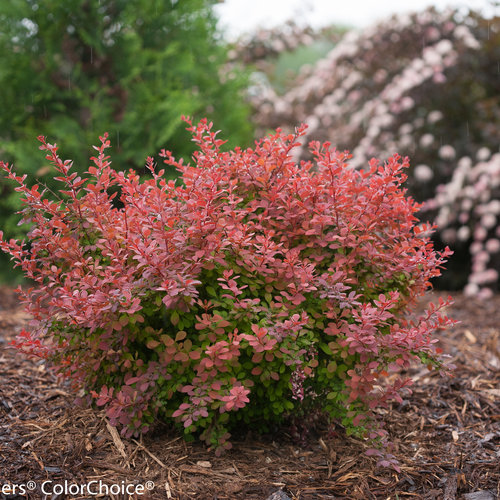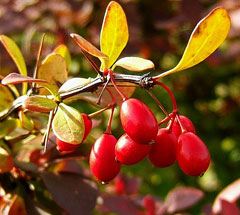Berberis thunbergii
Thunberg barberry (Berberis thunbergii )
The Thunberg barberry (Berberis thunbergii ), also called Green Hedges Barberry, a plant belonging to the family of Barberry is ( Berberidaceae ). Berberis thunbergii is native to Japan and China and was brought by the Swede Carl Peter Thunberg to Europe in the 18th century.
Description
The undemanding deciduous ( deciduous ) shrub can reach a height of up to 2 meters. It grows straight upright and is densely branched and spiny.
The upper side light green, bluish- green leaves are obovate, entire, and about 1 to 3 cm long. Your fall color ranges from bright orange to crimson. The leaf spines are usually simple and 5 to 15 mm long.
The small, shell -like flowers ( pale yellow, reddish outside ) are usually solitary or tufted pairs. The Thunberg barberry blooms from April to May
In autumn, the elongated bright red berries appear.
Propagation
Berberis thunbergii can be both generative and vegetatively propagated.
The seeds are sown immediately after harvest or stratified and applied in the spring.
Asexual reproduction occurs in December to march through woody or halbverholzte cuttings of about 12 cm length. The shorter spikes are removed and the timber placed in a light substrate must never dry out.
Diseases and Pests
Berberis thunbergii may be attacked by aphids or powdery mildew occasionally. Unlike Berberis vulgaris is no intermediate host of the cereal rust fungus.
Toxins, effect, symptoms
Like all Berberitzenarten also contain the Thunberg barberry mainly in leaves, bark and roots of the alkaloid berberine. The recording can stomach upset, vomiting, diarrhea, dizziness, shortness of breath, seizures even lead to kidney inflammation.
Use
Its flowers, the different leaf colorations and appearing in autumn berries lead to the use of the many varieties of Thunberg barberry as ornamental shrubs in gardens and parks. They also serve as bee pasture.
Varieties and hybrids
- B. th. ' Atropurpurea ' (blood barberry ), since 1913 in Culture
- B. th. ' Atropurpurea Nana' ( Small blood Barberry ), created in 1942 in the Netherlands
- B. th. 'Aurea ', cultivated since 1950
- B. th. ' Bagatelle ' (cross between B. th. 'Kobold ' and B. th. ' Atropurpurea Nana' ), since 1971
- B. th. 'Crimson Pygmy ' synonym for B. th. ' Atropurpurea Nana'
- B. th. 'Dart 's Red Lady '
- B. th. ' Erecta '
- B. th. 'Little Favorite' synonym for B. th. ' Atropurpurea Nana'
- B. th. 'Golden Ring', since 1950
- B. th. 'Green Carpet'
- B. th. ' Harlequin ', since 1969
- B. th. ' Helmond Pillar '
- B. th. ' Keller's Surprise'
- B. th. ' Kelleriis ', from Denmark
- B. th. 'Kobold ', bred in 1950 in the Netherlands
- B. th. 'Pink Queen', bred before 1958 in the Netherlands
- B. th. ' Red Chief ', 1942, The Netherlands
- B. th. 'Red Pillar '
- B. th. 'Rose Glow', bred in the Netherlands in 1957
- B. th. 'Silver Beauty'
- Berberis thunbergii var maximowiczii
The hybrids between B. thunbergii and B. vulgaris is ottawensis than B. × example, the hybrids between B. thunbergii and B. julianae referred to as B. × B. mentorensis.
Similarity to Berberis vulgaris
The two species differ mainly in the fact that Berberis thunbergii has small rounded leaves and Berberis vulgaris has major sawn leaves.









